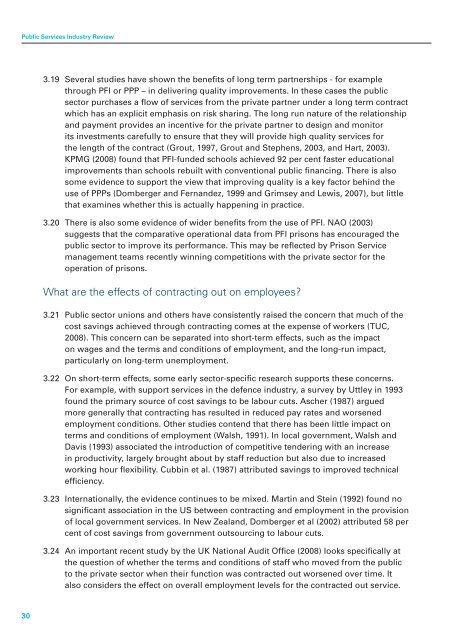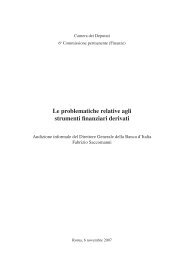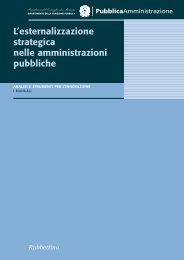Understanding the Public Services Industy
Understanding the Public Services Industy
Understanding the Public Services Industy
Create successful ePaper yourself
Turn your PDF publications into a flip-book with our unique Google optimized e-Paper software.
<strong>Public</strong> <strong>Services</strong> Industry Review<br />
3.19 Several studies have shown <strong>the</strong> benefits of long term partnerships - for example<br />
through PFI or PPP – in delivering quality improvements. In <strong>the</strong>se cases <strong>the</strong> public<br />
sector purchases a flow of services from <strong>the</strong> private partner under a long term contract<br />
which has an explicit emphasis on risk sharing. The long run nature of <strong>the</strong> relationship<br />
and payment provides an incentive for <strong>the</strong> private partner to design and monitor<br />
its investments carefully to ensure that <strong>the</strong>y will provide high quality services for<br />
<strong>the</strong> length of <strong>the</strong> contract (Grout, 1997, Grout and Stephens, 2003, and Hart, 2003).<br />
KPMG (2008) found that PFI-funded schools achieved 92 per cent faster educational<br />
improvements than schools rebuilt with conventional public financing. There is also<br />
some evidence to support <strong>the</strong> view that improving quality is a key factor behind <strong>the</strong><br />
use of PPPs (Domberger and Fernandez, 1999 and Grimsey and Lewis, 2007), but little<br />
that examines whe<strong>the</strong>r this is actually happening in practice.<br />
3.20 There is also some evidence of wider benefits from <strong>the</strong> use of PFI. NAO (2003)<br />
suggests that <strong>the</strong> comparative operational data from PFI prisons has encouraged <strong>the</strong><br />
public sector to improve its performance. This may be reflected by Prison Service<br />
management teams recently winning competitions with <strong>the</strong> private sector for <strong>the</strong><br />
operation of prisons.<br />
What are <strong>the</strong> effects of contracting out on employees?<br />
3.21 <strong>Public</strong> sector unions and o<strong>the</strong>rs have consistently raised <strong>the</strong> concern that much of <strong>the</strong><br />
cost savings achieved through contracting comes at <strong>the</strong> expense of workers (TUC,<br />
2008). This concern can be separated into short-term effects, such as <strong>the</strong> impact<br />
on wages and <strong>the</strong> terms and conditions of employment, and <strong>the</strong> long-run impact,<br />
particularly on long-term unemployment.<br />
3.22 On short-term effects, some early sector-specific research supports <strong>the</strong>se concerns.<br />
For example, with support services in <strong>the</strong> defence industry, a survey by Uttley in 1993<br />
found <strong>the</strong> primary source of cost savings to be labour cuts. Ascher (1987) argued<br />
more generally that contracting has resulted in reduced pay rates and worsened<br />
employment conditions. O<strong>the</strong>r studies contend that <strong>the</strong>re has been little impact on<br />
terms and conditions of employment (Walsh, 1991). In local government, Walsh and<br />
Davis (1993) associated <strong>the</strong> introduction of competitive tendering with an increase<br />
in productivity, largely brought about by staff reduction but also due to increased<br />
working hour flexibility. Cubbin et al. (1987) attributed savings to improved technical<br />
efficiency.<br />
3.23 Internationally, <strong>the</strong> evidence continues to be mixed. Martin and Stein (1992) found no<br />
significant association in <strong>the</strong> US between contracting and employment in <strong>the</strong> provision<br />
of local government services. In New Zealand, Domberger et al (2002) attributed 58 per<br />
cent of cost savings from government outsourcing to labour cuts.<br />
3.24 An important recent study by <strong>the</strong> UK National Audit Office (2008) looks specifically at<br />
<strong>the</strong> question of whe<strong>the</strong>r <strong>the</strong> terms and conditions of staff who moved from <strong>the</strong> public<br />
to <strong>the</strong> private sector when <strong>the</strong>ir function was contracted out worsened over time. It<br />
also considers <strong>the</strong> effect on overall employment levels for <strong>the</strong> contracted out service.<br />
30
















